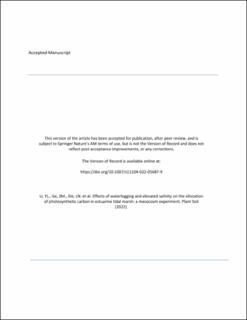| dc.contributor.author | Li, Ya-Lei | |
| dc.contributor.author | Ge, Zhen-Ming | |
| dc.contributor.author | Xie, Li-Na | |
| dc.contributor.author | Li, Shi-Hua | |
| dc.contributor.author | Tan, Li-Shan | |
| dc.contributor.author | Hancke, Kasper | |
| dc.date.accessioned | 2022-10-25T05:26:20Z | |
| dc.date.available | 2022-10-25T05:26:20Z | |
| dc.date.created | 2022-09-13T15:43:47Z | |
| dc.date.issued | 2022 | |
| dc.identifier.citation | Plant and Soil. 2022. | en_US |
| dc.identifier.issn | 0032-079X | |
| dc.identifier.uri | https://hdl.handle.net/11250/3028047 | |
| dc.description | Embargo until September 10, 2023 | en_US |
| dc.description.abstract | Background and aim Coastal marshes and wetlands hosting blue carbon ecosystems have shown vulnerability to sea-level rise (SLR) and its consequent effects. In this study, we explored the effects of waterlogging and elevated salinity on the accumulation and allocation of photosynthetic carbon (C) in a widely distributed species in marsh lands. Methods The plant–soil mesocosms of Phragmites australis were grown under waterlogging and elevated salinity conditions to investigate the responses of photosynthetic C allocation in different C pools (plant organs and soils) based on 13CO2 pulse-labeling technology. Results Both waterlogging and elevated salinity treatments decreased photosynthetic C fixation. The hydrological treatments also reduced 13C transport to the plant organs of P. australis while significantly increased 13C allocation percentage in roots. Waterlogging and low salinity had no significant effects on 13C allocation to rhizosphere soils, while high salinity (15 and 30 ppt) significantly reduced 13C allocation to soils, indicating a decreased root C export in saline environments. Waterlogging enhanced the effects of salinity on the 13C allocation pattern, particularly during the late growing season. The responses of flooding and elevated salinity on C allocation in plant organs and rhizosphere soils can be related to changes in nutrient, ionic concentrations and microbial biomass. Conclusion The adaptation strategy of P. australis led to increased C allocation in belowground organs under changed hydrology. Expected global SLR projection might decrease total C stocks in P. australis and alter the C allocation pattern in marsh plant-soil systems, due to amplified effects of flooding and elevated salinities. | en_US |
| dc.language.iso | eng | en_US |
| dc.publisher | Springer | en_US |
| dc.title | Effects of waterlogging and elevated salinity on the allocation of photosynthetic carbon in estuarine tidal marsh: a mesocosm experiment | en_US |
| dc.type | Peer reviewed | en_US |
| dc.type | Journal article | en_US |
| dc.description.version | acceptedVersion | en_US |
| dc.source.journal | Plant and Soil | en_US |
| dc.identifier.doi | 10.1007/s11104-022-05687-9 | |
| dc.identifier.cristin | 2051344 | |
| cristin.ispublished | true | |
| cristin.fulltext | postprint | |
| cristin.qualitycode | 2 | |
